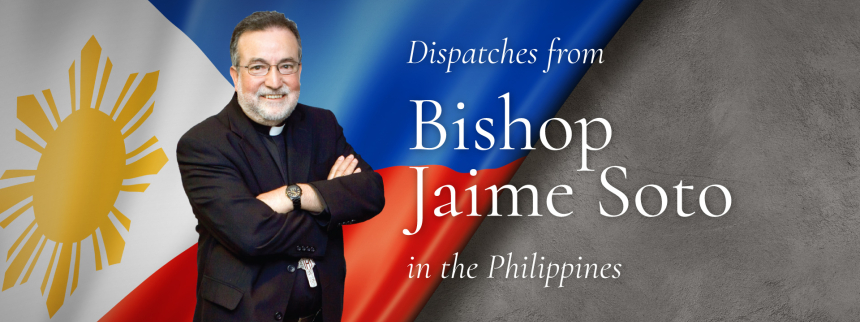
Visiting the Leyte region of the Philippine archipelago, there were many references and reminders of the Super Typhoon Yolanda. In 2013 this catastrophic climatic monster swept away everything in its capricious path. The most somber remembrance was the mass grave of Yolanda’s victims laid to rest on one side of the Cathedral in Palo. After visiting the Cathedral and praying, the pilgrims and I paid our respects to the quiet witnesses of nature’s fury whose tomb is adorned with a garden.
So many families lost loved ones during Yolanda. They brought their bodies to the Church. Archbishop John Du decided to bury the faithful departed together alongside the Church, serving as constant reminder for prayers as well as the abiding companionship of those who now share in the eternal liturgy of heaven.
The region, because of its geographical location, is customarily plagued by storms from the Pacific Ocean, but these have now become more aggravated by humanity’s naive ambivalence for the stewardship of the earth entrusted by the creator to us.
Archbishop John Du graciously received us in his home, which had been damaged by the Typhoon but was now restored. He showed us the dining room where Pope Francis visited with about 35 children chosen from among the many who had been orphaned by the storm. The Holy Father visited Tacloban City and Palo during his pastoral visit to the Philippines in 2015. Coming to this region during the difficult recovery was a much needed consolation to the local Church, said the Archbishop.
During the visit to Palo, we also visited Dreamville. This is a housing project supported by Catholic Relief Services from the United States. The project provided resettlement housing for more than 900 families dislocated by Yolanda. We drove through the narrow streets lined with homes and busy with families making their way. Archbishop John Du was exuberant in his gratitude for the assistance of the Catholic community in the United States in rebuilding the communities of Leyte.
While visiting in his home, the Archbishop showed me a beautiful statue of the Blessed Mother Mary, known by the name of Nuestra Señora de la Esperanza de Palo, Our Lady of Hope. The face of the Blessed Mother caught my attention. Her expression reflects compassion and empathy for the sufferings of her children. With one arm she holds her Beloved Christ Child at the waist. The infant Jesus is squirming in her arm as he reaches down to extend a rosary to a distressed Filipino child reaching up. This powerfully poignant Marian image offers hope for those moments that may seem hopeless. On the occasion of the coronation of Our Lady of Hope, Archbishop John Du said, “Our God has never abandoned us, and he has given us a mother—a mother to whom we could express our grieving, sadness, and mourning. She accompanies us in the journey and difficulties of life.”
These testimonies and so many that my fellow pilgrims and I heard and saw during our pilgrimage in the Philippines gave much encouragement in our faith. The resilience and perseverance of the different Filipino Catholic communities in the face of so many natural as well as social challenges is perhaps the best witness to the abiding presence of the Good Shepherd who first offered himself as the Bread of Life on the island of Limasawa more than five hundred years ago.
I hope you have enjoyed these reflections as much as I enjoyed preparing them for you.
Bishop Jaime Soto is currently on pilgrimage in the Philippines with a group of clergy and laity from the Diocese of Sacramento. Stay tuned to our News page for more of Bishop Soto's reflections from this pilgrimage.
Read more: First Dispatch - Second Dispatch - Third Dispatch - Fourth Dispatch - Fifth Dispatch

